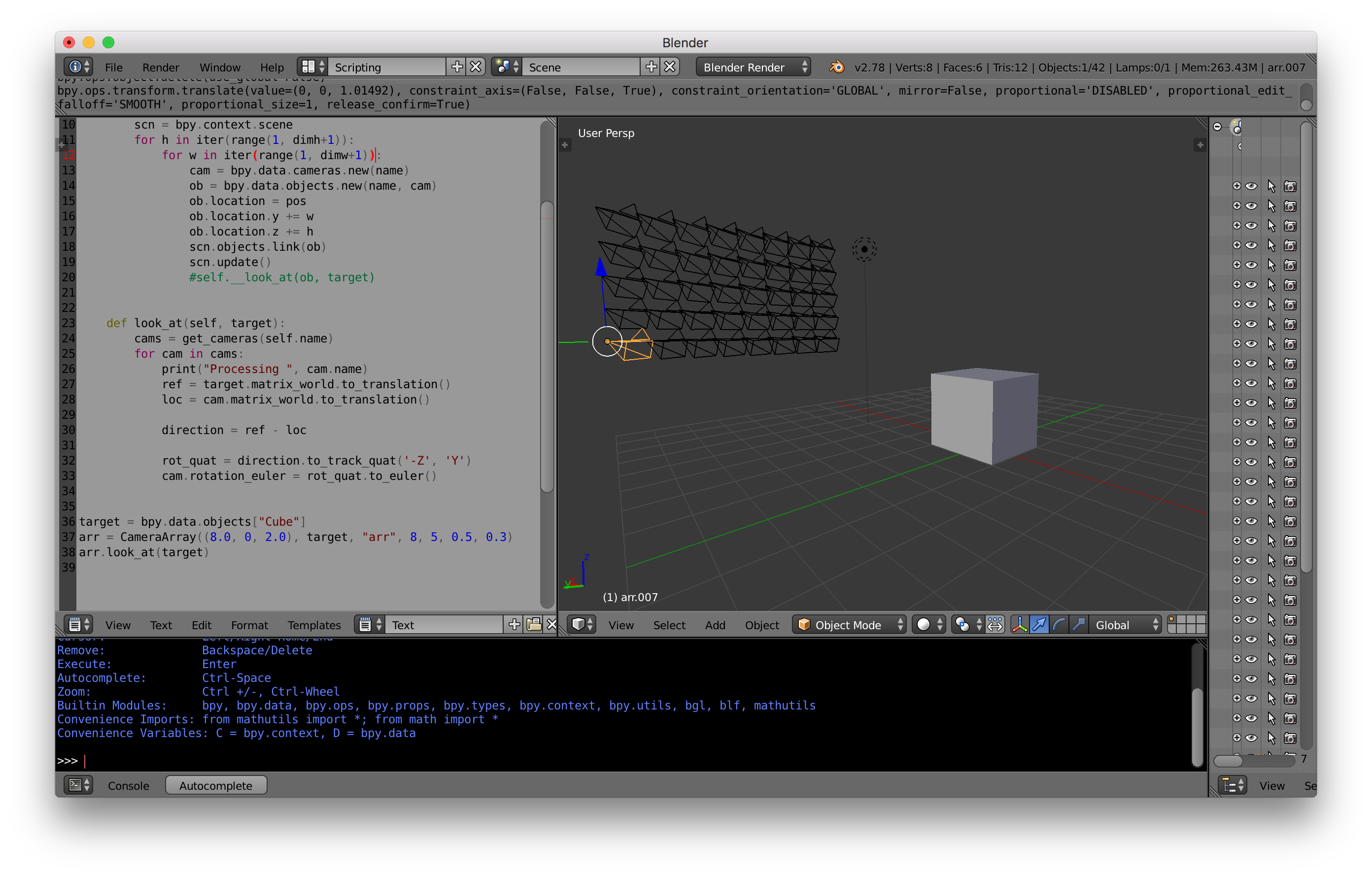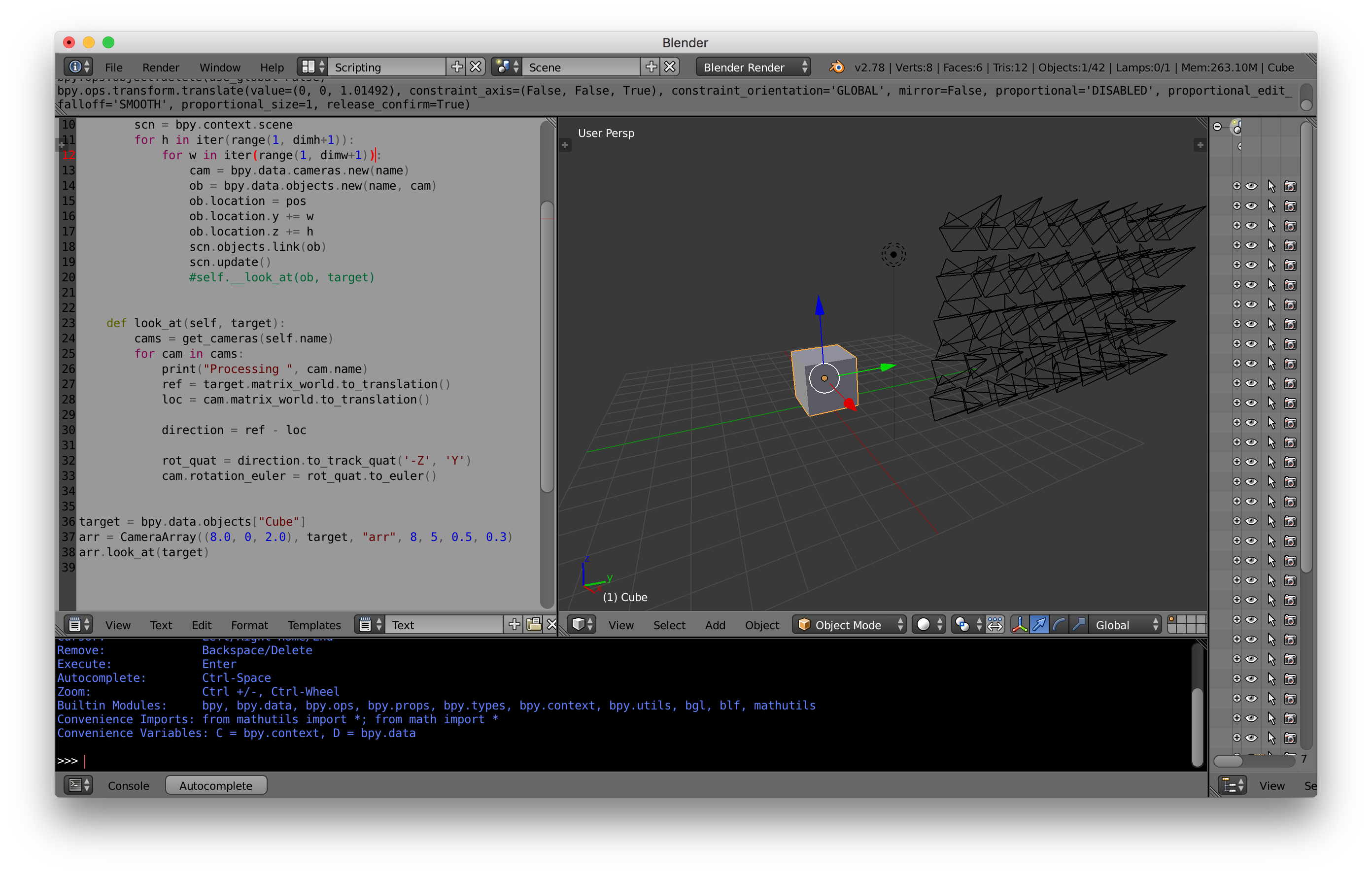The following script creates an array of cameras in position pos, looking at target, with a name prefix of dimensions dimwxdimh, with a distance between cameras specified by hdist and wdist.
import bpy
def get_cameras(prefix):
return [obj for obj in bpy.data.objects if( (obj.type =='CAMERA') and (prefix in obj.name) )]
class CameraArray:
def __init__(self, pos, target, name="array", dimw=10, dimh=8, hdist=1, vdist=1):
self.name = name
ref = target.matrix_world.to_translation()
scn = bpy.context.scene
for h in iter(range(1, dimh+1)):
for w in iter(range(1, dimw+1)):
cam = bpy.data.cameras.new(name)
ob = bpy.data.objects.new(name, cam)
ob.location = pos
ob.location.y += w
ob.location.z += h
scn.objects.link(ob)
scn.update()
#self.__look_at(ob, target)
def look_at(self, target):
cams = get_cameras(self.name)
for cam in cams:
print("Processing ", cam.name)
ref = target.matrix_world.to_translation()
loc = cam.matrix_world.to_translation()
direction = ref - loc
rot_quat = direction.to_track_quat('-Z', 'Y')
cam.rotation_euler = rot_quat.to_euler()
target = bpy.data.objects["Cube"]
arr = CameraArray((8.0, 0, 2.0), target, "arr", 8, 5, 0.5, 0.3)
arr.look_at(target)Untested. Renders scene from all cameras with prefix in their name.
# Render all cameras or cameras containing text given with command line argument "cameras".
# Example:
# Let's say test.blend file contains cameras "east.01", "east.02", "west.01", "west.02"
# By executing command "blender -b your_file.blend -P render_all_cameras.py" all 4 cameras will be rendered.
# Command "blender -b your_file.blend -P render_all_cameras.py cameras=east" will render "east.01" and "east.02" cameras.
# Command "blender -b your_file.blend -P render_all_cameras.py cameras=01" will render "east.01" and "west.01.02" cameras.
import bpy, bgl, blf,sys
from bpy import data, ops, props, types, context
print("\nThis Python script will render your scene with all available cameras")
print("or with camera(s) matching command line argument 'cameras'")
print("")
print("Usage:")
print("Render all cameras:")
print("blender -b your_file.blend -P render_all_cameras.py\n")
print("Render only matching cameras:")
print("blender -b your_file.blend -P render_all_cameras.py cameras=east\n")
cameraNames=''
# Loop all command line arguments and try to find "cameras=east" or similar
for arg in sys.argv:
words=arg.split('=')
if ( words[0] == 'cameras'):
cameraNames = words[1]
print('rendering cameras containing [' + cameraNames + ']')
print('\nPrint Scenes...')
sceneKey = bpy.data.scenes.keys()[0]
print('Using Scene[' + sceneKey + ']')
# Loop all objects and try to find Cameras
print('Looping Cameras')
c=0
for obj in bpy.data.objects:
# Find cameras that match cameraNames
if ( obj.type =='CAMERA') and ( cameraNames == '' or obj.name.find(cameraNames) != -1) :
print("Rendering scene["+sceneKey+"] with Camera["+obj.name+"]")
# Set Scenes camera and output filename
bpy.data.scenes[sceneKey].camera = obj
bpy.data.scenes[sceneKey].render.file_format = 'JPEG'
bpy.data.scenes[sceneKey].render.filepath = '//camera_' + str(c)
# Render Scene and store the scene
bpy.ops.render.render( write_still=True )
c = c + 1
print('Done!')
